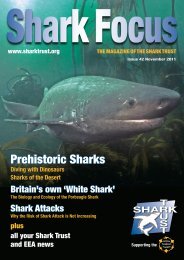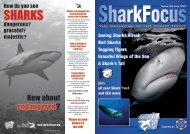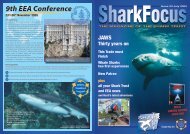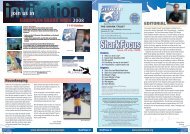Shark Focus
No Limits? - The Shark Trust
No Limits? - The Shark Trust
Create successful ePaper yourself
Turn your PDF publications into a flip-book with our unique Google optimized e-Paper software.
The No Limits? speciesNo Limits.Only a few decades ago the world’s oceans wereregarded as an inexhaustible resource.We now know these resources are finiteand under more pressure than ever before.Increasingly this is reflected in modernmanagement of fisheries resources, withsustainability now on most government agendasand firmly in the public sphere. In the NortheastAtlantic, commercially valuable fish stocks suchas cod, tuna and mackerel are managed usingan array of fisheries science, managing the fishand the fishing vessels in an effort to ensureadherence to catch limits whilst striving toachieve maximum sustainable yield (MSY – see<strong>Shark</strong> <strong>Focus</strong> 44). But this does not extend to allcommercially exploited species...1 2The Blue <strong>Shark</strong> Prionace glauca is a pelagic, oceanic shark, widespread in temperateand tropical waters down to 600m. Reaching a maximum size of 385cm, the speciesis relatively fast-growing and fecund, maturing in 4–6 years and producing averagelitters of 35 pups. Blue <strong>Shark</strong>s are highly migratory, utilising major current systemssuch as the Gulf Stream to undertake vast clockwise trans-Atlantic movements. Alongthe way they prey on pelagic fish and cephalopods while, like many pelagic sharks,segregating by sex and size.Research suggests approximately 10.7 million Blue <strong>Shark</strong>s are killed annually for theirfins, making up 17% of fins traded in the Hong Kong market 7,8 . With no populationestimates for the species, and a considerable volume of catch likely going unrecordedeach year, particularly in high-seas fisheries, there are concerns surrounding thesustainability of Blue <strong>Shark</strong> fisheries – a concern reflected in the Blue <strong>Shark</strong> beinglisted as Near Threatened on the IUCN Red List of Threatened Species.The Shortfin Mako Isurus oxyrinchus is a wide-ranging pelagic, oceanic shark foundin temperate and tropical waters to at least 500m. Reaching a maximum size of400cm, Shortfin Mako feed mainly upon large teleosts such as tuna and swordfish.Relatively little is known of this shark’s biology, in part reflecting the difficulty ofstudying a large, fast-swimming marine predator. Although caught in less volumethan the Blue <strong>Shark</strong>, Shortfin Mako account for at least 2.7% of fins in the HongKong market – the equivalent of approximately 1 million individual sharks 7,8 . This, inconjunction with a reproductive rate considerably lower than that of the Blue <strong>Shark</strong>,has resulted in the Shortfin Mako assessed as Vulnerable on the IUCN Red List.Graphs show global Blue <strong>Shark</strong> (left) and Shortfin Mako (right) catch reported by EU MemberStates: 1990 – 2011 (live-weight, tonnes). Source: FishStatPlus, Food and AgricultureOrganisation of the United Nations (FAO).UnlimitedEach year millions of highly-migratory Blue and ShortfinMako <strong>Shark</strong>s are taken as ‘wanted bycatch’ in Atlantichigh-seas tuna and billfish fisheries. In fact, analysissuggests Blue <strong>Shark</strong>s are the predominant catchcomponent in these fisheries. For example, between2000 and 2004 Blue <strong>Shark</strong>s made up 61% of the totallanded catch in the Spanish longline fishery for Atlanticswordfish 1 . Similarly, Blue <strong>Shark</strong>s can comprise up to86% of the total catch in the Portuguese longline fisheryfor swordfish in the Azores 2 . In the same fisheries, ShortfinMako account for 7% and
















